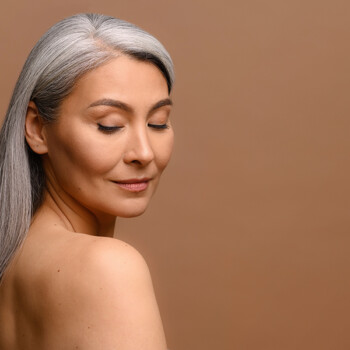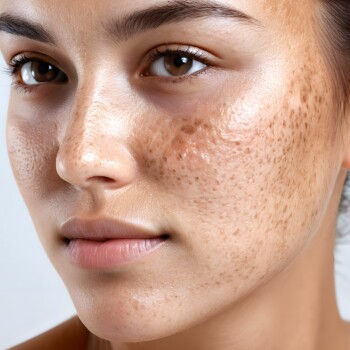Article Summary
Hydroquinone (HQ) is a topical ingredient commonly used to potentially reduce the appearance of hyperpigmentation and may promote a more even skin tone. This article reviews how HQ may work, its potential benefits for conditions like melasma and age spots, and highlights research on its use alone or alongside laser therapy. While results may vary, professional guidance is key to safe and effective treatment.In the pursuit of more even-toned skin, many providers and patients have turned to hydroquinone (HQ) as a possible solution. According to a review of research surrounding HQ, it is arguably one of the most effective ingredients when used alone or with certain ingredients, in its potential to reduce the appearance of hyperpigmentation. [1]
How HQ May Work
HQ may work by potentially inhibiting the enzyme tyrosinase, which is involved in synthesizing melanin, the pigment responsible for skin color. This reduction in melanin production may help lighten the skin and reduce the appearance of dark spots and discoloration. [2]
Potential Benefits of Hydroquinone for Skin
Given its history in assisting with various types of hyperpigmentation, HQ continues to be a potentially valuable tool in dermatological practice. Let’s delve deeper into its possible benefits for skin health.
Potential Use in Hyperpigmentation
HQ is suggested to be particularly helpful in reducing signs of melasma. A literature review suggests that using a combination of 3% hydroquinone twice a day and sunscreen once a day was associated with reducing the appearance of melasma compared to using HQ alone. [3]
The Result: The study observed a 96% improvement in melasma appearance with the combination treatment, while HQ alone showed an 81% improvement. [3]
Anti-Aging Properties
HQ may also contribute to anti-aging efforts. By potentially fading solar lentigines (also known as age spots, caused by UV radiation and other environmental factors)4, it may promote a more youthful appearance.
A study examined the effectiveness of a 2% hydroquinone-cyclodextrin cream on age spots on the forearms of 30 Asian adults. Participants applied the cream once daily for two months to one forearm while the other remained untreated as a control. [3]
The Result: After two months, the untreated forearms showed no significant change in the appearance of age spots. However, the forearms treated with the hydroquinone-cyclodextrin cream experienced a noticeable lightening of the age spots after one month. [3]
HQ in Combination with Other Drugs
Kligman’s formula, which combines HQ, tretinoin and dexamethasone, a corticosteroid, was pioneered and developed in 1975 by dermatologist Dr. Albert M. Kligman.[5,6] Dr. Kligman’s research suggested a complete depigmentation in the normal skin of black people within 5 – 7 months. [6]
Including HQ, each ingredient plays a crucial role:
- Tretinoin is a retinoid that may help promote cell turnover, and improve the penetration of hydroquinone. [7,8] Tretinoin may also stimulate the production of collagen, which may help maintain skin elasticity and reduce fine lines and wrinkles. [8,9]
- Corticosteroids are steroid hormones that may help reduce inflammation and irritation, which can be associated with hyperpigmentation.[10]
HQ Combined with Laser Therapy
Some dermatologists and healthcare providers may pair HQ with laser treatments like fractional CO2 laser therapy to potentially enhance the reduction of hyperpigmentation.
A particular study evaluated the effectiveness of hydroquinone 4% alone and in combination with fractional CO2 laser for treating melasma. The severity of melasma lesions based on darkness and homogeneity were assessed along with patient satisfaction. [11]
Forty women with bilateral melasma participated in a randomized, single-blind trial. One side of each patient’s face received hydroquinone 4% cream, while the other side received the same cream plus three sessions of fractional CO2 laser therapy at 3-week intervals. Both sides continued using hydroquinone for three months after the laser treatments. [11]
The Result: The study found that the combination of hydroquinone and laser therapy led to a significant reduction in melasma darkness after 3 weeks for those using the combined therapy. Results were visible after 6 weeks using just HQ. [11]
Potential Side Effects and Precaution
- While hydroquinone may be effective, it is not without risks. Some common side effects may include skin irritation, redness, dryness, and mild contact dermatitis. [2]
- In rare cases, long-term use or misuse of hydroquinone may lead to ochronosis, a condition that causes bluish-black pigmentation of the skin. [2]
- It is crucial to use hydroquinone under the guidance of a healthcare professional, especially for individuals with sensitive skin or those prone to allergies.
- Users are advised to avoid sun exposure or use sunscreen diligently while undergoing treatment to prevent further skin damage. [2]
- If you are considering hydroquinone, consult a dermatologist to determine the appropriate treatment plan and concentration for your skin type and condition.
The Empower Pharmacy Difference
Empower Pharmacy compounds high-quality medications using active pharmaceutical ingredients (APIs) from FDA-registered sources. Our commitment to quality and cutting-edge healthcare solutions is evident in our innovative approach to compounding.
FAQs
What is hydroquinone, and how does it work?
Hydroquinone is a topical medication commonly used to help lighten dark spots on the skin, a condition known as hyperpigmentation. It may inhibit the production of melanin, the pigment that gives skin its color. [2]
What are the common uses for hydroquinone?
Hydroquinone is commonly used to assist with conditions such as melasma, chloasma, freckles, age spots, and post-inflammatory hyperpigmentation. It may also be used to help lighten overall skin tone. [2]
Is hydroquinone safe to use?
Hydroquinone should only be used as directed by a healthcare professional. It may cause side effects such as skin irritation, dryness, or allergic reactions. Long-term use may also lead to ochronosis, a rare condition that can cause blue-black discoloration of the skin. [2]
How long does it take to see results with hydroquinone?
Results may vary depending on the individual and the severity of hyperpigmentation. Generally, it may take several weeks or months of consistent use to notice significant improvement.2 Consult your healthcare provider to determine the best treatment option for you.
Can hydroquinone be used for all skin types?
It’s essential to consult with a dermatologist to determine if it’s suitable for your specific skin condition and to discuss potential side effects.
Important Disclaimer: Empower Pharmacy’s products are not FDA-approved and are not tested by the FDA for efficacy or safety. The information provided is for informational purposes only and is not intended as a substitute for professional medical advice. Always seek the advice of a qualified health professional with any questions you may have regarding a medical condition or treatment.
View our entire aesthetic portfolio to meet your patient’s needs.
Contact a clinic liaison today to discover how we can support your practice’s needs.
1. McKesey, J., Tovar-Garza, A., & Pandya, A. G. (2019). Melasma Treatment: An Evidence-Based Review. American Journal of Clinical Dermatology, 21(2). https://doi.org/10.1007/s40257-019-00488-w.
2. Schwartz, Chelsea, et al. “Hydroquinone.” StatPearls – NCBI Bookshelf, 22 Aug. 2023, http://www.ncbi.nlm.nih.gov/books/NBK539693.
Fabian, Isabella M., et al. “Topical Hydroquinone for Hyperpigmentation: A Narrative Review.” Cureus, Nov. 2023, https://doi.org/10.7759/cureus.48840.
Nakamura, Motoki, et al. “Environment‐induced Lentigines: Formation of Solar Lentigines Beyond Ultraviolet Radiation.” Experimental Dermatology, vol. 24, no. 6, Apr. 2015, pp. 407–11. https://doi.org/10.1111/exd.12690.
Casale, J., Taylor, A., & Crane, J. (2023, January 1). Albert M. Kligman, MD (1916-2010): a controversial genius in the field of dermatology. PubMed Central (PMC). https://www.ncbi.nlm.nih.gov/pmc/articles/PMC9891217/
6. Chandra, Mekhala, et al. “Hydroquinone Therapy for Post-inflammatory Hyperpigmentation Secondary to Acne: Not Just Prescribable by Dermatologists.” Acta Dermato Venereologica, vol. 92, no. 3, Jan. 2012, pp. 232–35. https://doi.org/10.2340/00015555-1225.
7. Zasada, Malwina, and Elżbieta Budzisz. “Retinoids: Active Molecules Influencing Skin Structure Formation in Cosmetic and Dermatological Treatments.” Advances in Dermatology and Allergology, vol. 36, no. 4, Jan. 2019, pp. 392–97. https://doi.org/10.5114/ada.2019.87443.
8. JDDonline – Journal of Drugs in Dermatology. “A Method for Maintaining the Clinical Results of 4% Hydroquinone and 0.025% Tretinoin With a Cosmeceutical Formulation – JDDonline – Journal of Drugs in Dermatology.” JDDonline – Journal of Drugs in Dermatology, com/articles/a-method-for-maintaining-the-clinical-results-of-4-hydroquinone-and-0025-tretinoin-with-a-cosmeceuti-S1545961615P0386X#:~:text=Its%20activity%20can%20be%20augmented,a%20penetration%20enhancer%20for%20the.
9. Griffiths, Christopher, et al. “Restoration of Collagen Formation in Photodamaged Human Skin by Tretinoin (Retinoic Acid).” New England Journal of Medicine, vol. 329, no. 8, Aug. 1993, pp. 530–35. https://doi.org/10.1056/nejm199308193290803.
10. Davis, Erica C., and Valerie D. Callender. “Postinflammatory Hyperpigmentation: A Review of the Epidemiology, Clinical Features, and Treatment Options in Skin of Color.” PubMed Central (PMC), 1 July 2010, http://www.ncbi.nlm.nih.gov/pmc/articles/PMC2921758.
11. Naeini, Farahnaz Fatemi, et al. “Combination of Hydroquinone and Fractional CO2 Laser Versus Hydroquinone Monotherapy in Melasma Treatment: A Randomized, Single-blinded, Split-face Clinical Trial.” Indian Journal of Dermatology, vol. 64, no. 2, Jan. 2019, p. 129. https://doi.org/10.4103/ijd.ijd_240_17.
Tan, C. (2018, November 9). What is Hydroquinone? Harley Street Medical Doctors. https://harleystreet-md.co.uk/blog/what-is-hydroquinone/




